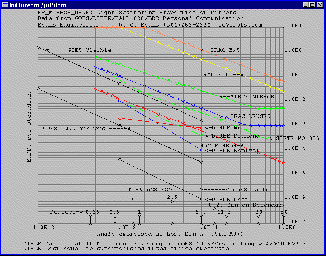Side View: Diffraction Edges, "White Throat" - Isometric View : Diffraction Edges, "White Throat"
Preliminary APART Modeling Results
(Last updated: July 8, 1998)
Comparison of AutoCAD, Code-V, I-DEAS input 3-D models and APART output 3-D models.
Input 3D model information came from the following sources. The 3D positioning of all the optical and mechanical elements traces directly to either the Code-V model of the IDM (Instrument Development Model) or the I-DEAS drawings that were used to fabricate the IDM.
The following images are plots generated by APART from the basic input 3D model data. They consist of the basic optical system only. The analysis has only been done between 0.25 to 3.5-degrees off axis. Added detail to the model will not contribute to stray light in this angular region. Objects modeled are:
-
Side View: Diffraction Edges, "White Throat" - Isometric View : Diffraction Edges, "White Throat"
Top View: Diffraction Edges,
"White Throat"
-
Side View of Thermal Sources - Close-up of Thermal
Sources (Isometric View)
Single Side View Comparing AutoCAD, Code-V, I-DEAS and APART
Image Surface Irradiance Distribution
-
Thermal Sources (1, 2, 3, 4, & 6 arc-min off-axis)
-
Point Source (0.25, 0.5, 0.75, 1.00, & 1.25 degrees off-axis)
-
Point Source (1.5, 2.0, 2.5, 3.0 & 3.5 degrees off-axis)
 BRDF Data Set for IRAC (with
data from other sources for comparison)
BRDF Data Set for IRAC (with
data from other sources for comparison)
IRAC Performance Summary - APART Analysis
- PST is presented in PSNIT units. This is determined by the APART program input request.
- PST=Point Source Transmittance
- PSNIT=Point Source Normalized Incidence Transmittance. PSNIT=(POWER OUT/UNIT AREA) / (POINT SOURCE IRRADIANCE AT THE INSTRUMENT)
- Power In is 1 unit of power per unit of area perpendicular to a collimated source. This can be scaled or be considered as 1 watt/sq. inch for the input power.
- Power Out is in units of power on the detector. For 2.0 degrees it is nominally 0.90E-3 units or watts.
- The Area of the input aperture is 776.87306 square inches. [DISK 50 10 -1 0.000 16.920 6.245 *Primary Mirror] pi x(16.9202-6.2452)= 776.87306 sq. inches
- The Area of the Detector used was 0.102 square inches. (Conversion round-off errors from square to circle) [RECT 198 8 1 5.590896-.340 0.1614175] = (2 x 0.1614175)2 = 0.10422244
- At 2-degrees, the output power is 0.90E-3 units. The PSNIT = (0.91E-3 /0.102) / (1) = 0.0089215686; Log PSNIT = ¯2.0495588
- The input power from a point source is 777 units. If that power were focused on a 3x3 pixel area, the flux would be 86 units/pixel. The residual flux at 2 degrees off axis is spread over a 256 x 256 pixel detector. The flux per pixel is 0.9E-3 /(256 x 256) = 1.37E-8 units/pixel. This is equivalent to a point source signal reduction of about 1E-10. If the source were the sun, we would still have about 10 orders of magnitude to go to be background limited. The GOES 30 cm diameter telescope can detect 6th magnitude stars with a SNR of 2 with the sun about 6 degrees away from the optical axis.
- Primary & Secondary Mirrors (Value used by J. Fleming for SIRTF). COATING 22 MIRROR 0.30 SLOPE -1.06 MIN BRDF 5.E-3 MAX BRDF 1.0 *HDOS + CL600
- Pick-off Mirror BRDF is 10 times higher than the DIRBE coating. From the DIRBE data, the diamond turned mirrors were about 10 times worse than the polished mirrors (at 10.6 microns). COATING 23 1.2305E-02 -1.30173 *30 A Mir-10xDIRBE
Point Source Normalized Incidence Transmittance.
[Cycle] Angle Log PSNIT
[1] 0.25
-1.00
[2] 0.50 -1.32
[3] 0.75 -1.51
[4] 1.00
-1.65
[5] 1.25 -1.76
[1] 1.5
-1.87
[2] 2.0 -2.05*
[3] 2.5 -2.22
[4] 3.0 -2.36
[5] 3.5 -2.48
2.0-degree Log PST Required -1.3
Percent
Contribution from Top Ten Paths at 2.0-degrees off-axis
(Contribution from 0.25 to 3.5-degrees off-axis is basically the
same)
Edge Diffraction is included, but negligible!
Primary
(50) 16.98%
Secondary (60) 77.64%
Pick-off (101) <0.00%
Lens-A (144) <0.00%
Lens-B (147) <0.01%
Beam Splitter (158) 2.85%
Filter (167) 2.47%
Pupil Stop (182) 0.05%
There were 25
paths that had power to the detector.
Throat Wall had 100% Lambertian Surface and less than 0.00%
contribution.